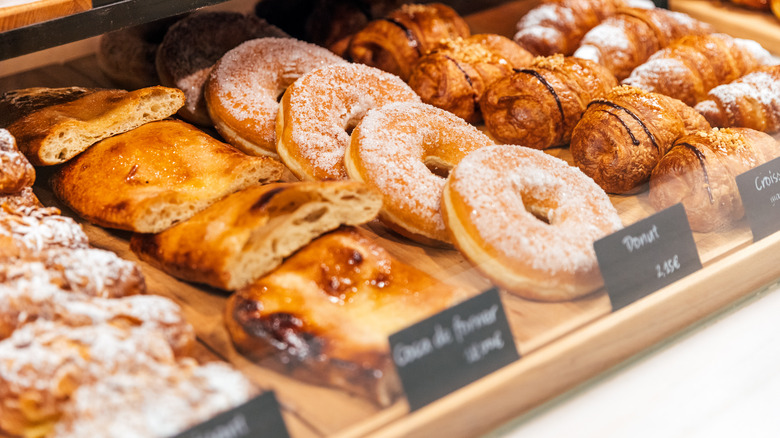How Grocery Store Displays Trick You Into Buying More
If you go into a grocery store with a set list but always feel tempted to spend more, this is intentional. These businesses understand the psychology behind what store layouts, ambiance, and product placements catch your attention. Trying a new product (or two) is fun, and it's okay to budget for some impulse buys, but grabbing multiple products that you may not need is an easy way to spend extra money and even waste food. When you understand grocery store tactics, your wallet and the planet will thank you later.
Consider the location of the items you typically need most. Milk, eggs, and butter are frequent items on many shopping lists — but these grocery staples are always tucked away at the back of a store. To get to these high-priority products, you need to walk by many other items, aisles, and displays — all designed to distract you from your original goal. Other staples, like fresh produce, may be located on the other side of the store.
Items that catch your eye the most are those at eye level. That's right: The height at which certain items are displayed is also planned to tempt you. This ploy works well for the kids, who might find themselves looking at colorful cereal boxes with cartoon characters, perfectly placed at their shorter height. Meanwhile, high-value or new items may be placed at the eye level of the average adult to catch their attention first.
Watch out for end caps
No matter what aisle you go down, you'll always pass end caps, the outward-facing sections at the end of each section. They display flashy new items and fun seasonal specialties, like Christmas-inspired peppermint mocha creamer, candy canes, and gingerbread cookies. This is a great location for the newest stock — and of course it encourages you, the customer, to try it out.
Another end cap strategy is displaying items that pair well together. There could be local coffee beans with a box of Italian biscotti or a variety of crunchy and salty snacks next to a six-pack for an upcoming game. The narrative here is "You're buying one, so don't forget the other."
You might have unknowingly walked by these products in the aisle, but when displayed in this curated manner, they're impossible to miss. These displays communicate why you should buy in a very straightforward manner. Even if the products aren't on your grocery list, it's a convincing reminder to not forget the perfect pairing, a limited edition holiday product, the last-minute garnish, a tasty-looking new product, or a sale item.
Promotions and psuedo-sales
Grocery stores always make sure items on sale are upfront and impossible to miss. They'll be toward the front of the store, with a large or eye-catching sign, or arranged in a visually appealing display. But though it's worth buying products we eat frequently when they're on sale, some deals and discounts should be avoided. Just because something is cheaper, doesn't mean you need it. Saving a few dollars or cents only really matters if you eat the product — don't buy anything on sale unless you're sure you'll like it or use it.
One of the most misleading tactics employed by grocery stores is the fake sale sign. Well, it's not exactly fake — but it looks like it's signifying a sale, possibly with red or yellow colors. Instead, it is simply displaying the regular price of the item. Another telltale indicator of this trick is that instead of listing a percentage or amount of money discounted, the sign reads "low, everyday price" or "unbeatable prices". While the amount listed may very well be low, the color or style of the sign is intended to fool your brain into thinking it is a sale, subconsciously tricking you into buying more.
Again — be aware of the end caps. In addition to displaying select products, discounted items may also be homed here. These could be seasonal items that need to be phased out or those that haven't sold well.
Ambiance, aroma, and visuals
Does it smell like toasted bagels or freshly baked cookies? Are you getting a whiff of roasted meat? Chances are there is a display of baked goods or rotisserie chickens nearby, strategically placed where the aromas are strongest to encourage a purchase. There may even be a free sample available — like Trader Joe's and Costco offer — to seal the deal. How food, alcohol, flowers, and other products are creatively displayed is also intended to increase customer spending. Gourmet cheeses could be arranged by country of origin, and fresh fruits and vegetables could be stocked in wood baskets to amplify their appeal.
Although we strongly associate grocery stores with fluorescent lighting, advances in LED options have led to more experimentation in these businesses to alter the customer experience and influence their behavior. Sometimes, pricier products are highlighted with brighter lighting on a central display. Pleasant, warmer tones can cause customers to linger more — and the longer they linger, the more likely they are to spend more.
Grocery displays and tactics get even the most frugal, focused shoppers. It sounds mundane and repetitive, but going in prepared with a list is the best way to stay immune to grocery store tricks. Don't take all the fun out of it, though — if your budget permits, allow yourself five extra minutes and one to two impulse buys per week.



